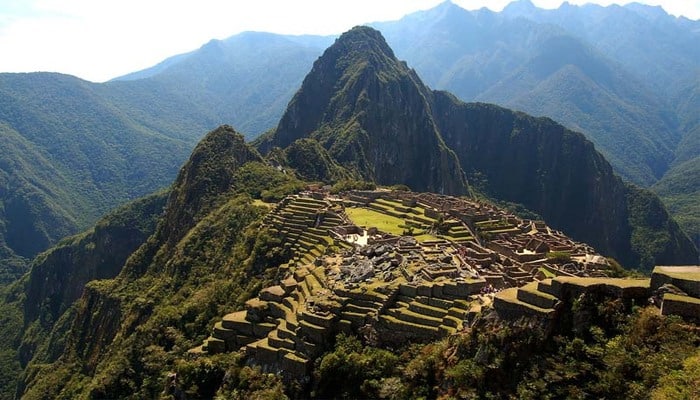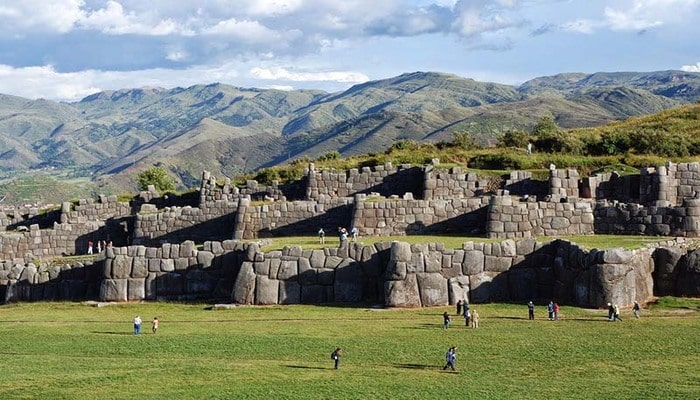The Inca mega constructions. How were they made?
The Incas made truly incredible architectural works. With patient and massive work, they managed to perfectly fit rocks weighing more than 120 tons. As an example, there are today amazing archaeological sites such as: Sacsayhuaman, Coricancha, Choquequirao, Moray, Machu Picchu and more. But how did the Incas build such magnificent constructions? Learn more here!
Tabla de Contenido
Free Tour Cusco 2023
Hurry up! Cusco is waiting for you
Book now!
Machu Picchu, wonder of the world
Machu Picchu is, without a doubt, one of the mega constructions of Inca engineering. It is also recognized as one of the seven wonders of the modern world.
It was built by order of Emperor Pachacutec in 1450 AD. approximately.
Its construction required the participation of more than a thousand men from different regions of the empire (under the mitimaes system).
Its location is no accident. There abounds the ideal granite stone for the construction of its temples and enclosures. So the work was less. In addition, Machu Picchu is located on a geological fault.
Even so, Machu Picchu is an unfinished work. In its mountains and limits there are temples and unfinished enclosures. Apparently the inhabitants had to flee from there during the wars between the Incas and the Spanish between 1537 and 1572.
The works in Machu Picchu were patient and progressive. It is estimated that it took almost 50 years. Those responsible for its construction at first lived there (the citadel can accommodate between 300 and 1,000 people).
Today Machu Picchu is Peru’s top tourist destination in South America.
- Where is it located? Aguas Calientes district, Urubamba province, Cusco department in Peru.
- How much is admission? Adult foreigners 152 soles, Peruvian adults 64 soles.

Sacsayhuaman, Inca fortress
Sacsayhuaman is the most mysterious and surprising construction of the Incas.
The reason? The Incas used the largest stones for its construction. How did they manage to perfectly move, carve and fit rocks weighing up to 120 tons?
According to various investigations, the Incas managed to build Sacsayhuaman after patient work involving more than 20,000 men over a period of almost 100 years.
The work of moving the stones was arduous since it is estimated that the stone bank was on top of a hill 20 kilometers away.
Sacsayhuaman was a work prior to the Incas. They improved their constructions until reaching their megalithic form. This facilitated its construction.
It was the emperor Pachacutec in the fifteenth century who ordered its rebuilding.
During the battle of Sacsayhuaman between the Incas and the Spanish (1536), the enclosures and walls of the place were destroyed. In addition, the Spanish used part of its rocks to build the Cathedral of Cusco.
Today the same Sacsayhuaman shows its incredible constructions that seem to resist forever the passage of time.
- Where is it located? 4 kilometers from the city of Cusco in Peru.
- How much is admission? 70 soles with the Cusco Tourist Ticket (40 soles for Peruvians).

Coricancha, the temple of the sun
Coricancha was the most important and respected Inca temple in Inca times.
Its construction was ordered by the emperor Pachacutec in the fifteenth century. For these works, huge rocks were brought from the surrounding high mountains. In addition, fine sheets of gold, silver and precious stones were brought from all over the empire.
The walls of the Coricancha demonstrate the finest stonework of the entire Inca empire. It is believed that this was performed by hundreds of men over a period of more than fifty years.
However, recent research suggests that the foundations of the Coricancha predate the Incas. Its original name was Inticancha (temple of the sun) and its first walls were built by the Ayamarcas in the thirteenth century (predecessors of the Incas in the Cusco valley).
The Coricancha is so resistant and perfect that it has managed to resist in good condition up to three earthquakes of great intensity: in 1650, 1749 and 1950.
On the foundations of the Coricancha the Spanish built the temple and convent of Santo Domingo. This colonial structure did suffer the consequences of these earthquakes. The Coricancha is still intact.
- Where is it located? Just 600 meters from the Plaza de Armas of Cusco.
- How much is admission? 15 soles.

Ollantaytambo, living Inca city
Ollantaytambo was a town that bordered the flourishing empire of the Incas. In the fifteenth century, under the orders of Emperor Pachacutec, this town was annexed to Tahuantinsuyo.
Pachacutec ordered the construction of a citadel and religious center for the elite. The rest of the population lived in the lower part of the town (current town of Ollantaytambo).
For the construction of Ollantaytambo, the Incas took advantage of the stone benches in the upper part, on the banks of the Urubamba River.
Hundreds of foreign settlers were used for the works under the mitimaes system. Constructions like the Temple of the Sun would have taken more than 50 years to build.
The Temple of the Sun is a building made up of six monoliths or stone blocks of more than one hundred tons each. These granite blocks fit together perfectly thanks to patient carving work.
In addition, Ollantaytambo has ceremonial centers, platforms, royal baths, colcas (warehouses), viewpoints and more. The works in this citadel could have taken more than 50 years.
Unfortunately during the battle of Ollantaytambo (in January 1537) between the Spanish and the Incas, part of the buildings were damaged.
- Where is it located? 60 kilometers by road from the city of Cusco. It belongs to the province of Urubamba in the so-called Sacred Valley of the Incas.
- How much is admission? 70 soles with the Cusco Tourist Ticket (40 soles for Peruvians).

Choquequirao, the sacred sister of Machu Picchu
Choquequirao certainly has similarities with Machu Picchu.
This Inca city is located in a mountainous landscape with abundant vegetation. Its architecture is made up of enclosures, temples, platforms, squares and even a cemetery with a resemblance to Machu Picchu.
The construction of this citadel is attributed to two Inca emperors: Túpac Yupanqui (1471 – 1493) and Huayna Cápac (1493 – 1527).
The workforce was brought from different towns subjected by the Incas under the mitimaes system (population transferred in favor of the Incas).
The Incas built Choquequirao in an area with abundant granite stone, which facilitated the work of carving and moving rocks.
This citadel fulfilled an important function as a control point towards the Vilcabamba valley. Even the Incas built a route of roads that connected with Machu Picchu.
The carving of its main temples and residential areas show that patient and progressive work was carried out that could have taken more than 50 years.
Today Choquequirao can only be accessed through an intense 2-day trek (departing from the town of Cachora). This route is called ‘Choquequirao trek’.
- Where is it located? High up and north of the Apurimac River, at 3,103 meters above sea level (you can only get there through a 2-day hike).
- How much is admission? Adults in general 60 soles, university students 30 soles and children 25 soles.

Moray, the surprising circular platforms
Moray is one of the most beautiful and, at the same time, mysterious Inca mega-constructions.
At first glance it looks like a large circular amphitheater. However, in reality it is a system of platforms where the Incas were able to harvest different products that, under normal conditions, could not germinate.
Its construction is a mystery because the excavation of holes of such a size would take a long time. That is why it is believed that those large holes were produced millions of years ago after the collapse of meteorites.
The truth is that before the arrival of the Incas, the place was inhabited by the Ayamarca and Mara ethnic groups. After being conquered by the Incas, the system of terraces that can be seen today was built.
The Incas were experts in building this type of platform for agriculture. To do this they dug irrigation canals and affirmed the land with several layers of stones and earth. Thus, the platforms remain in a good state of conservation until today.
In Moray, the Incas planted various products such as potatoes, corn, oca, quinoa, and it is even believed that the coca leaf.
Moray is made up of three large circles and one small one. Today it is one of the best tourist attractions in Cusco and the Sacred Valley of the Incas.
- Where is it located? 50 kilometers from the city of Cusco. It belongs to the community of Maras in the Sacred Valley of the Incas.
- How much is admission? 70 soles with the Cusco Tourist Ticket (40 soles for Peruvians).

Waqrapukara, Inca castle
Waqrapukara resembles a huge Inca castle. Precisely its name, translated from the Quechua language, means ‘Fortress in the form of a horn’.
However, the true function of Waqrapukara was that of a ceremonial center.
Like all Inca temples, Waqrapukara has finely carved stone enclosures. To get there you had to take an arduous walk along Inca trails. Some researchers point out that it was a pilgrimage.
But how was such a building built? The origins of Waqrapukara date back to pre-Inca times. This structure belonged to the Canchis culture who allied themselves with the Incas in 1440.
The Incas, aware of the importance of such a rock structure, decided to adapt it to their architectural structures. It was the emperor Túpac Yupanqui (1471 – 1493) who ordered the construction of temples and platforms similar to other citadels such as Pisac or Ollantaytambo.
The main horn-shaped structure is a natural cavern adapted with windows and niches for religious rituals.
For the construction of Waqrapukara, a population of other distant ethnic groups recently subdued under the mitimaes system was used.
It is currently one of the most beautiful tourist attractions in Cusco. Even so, it is not visited by the number of tourists expected.
- Where is it located? 2 hours by car from the city of Cusco (includes a walk of 2 hours on average). It belongs to the province of Acomayo.
- How much is admission? General admission costs 10 soles.







